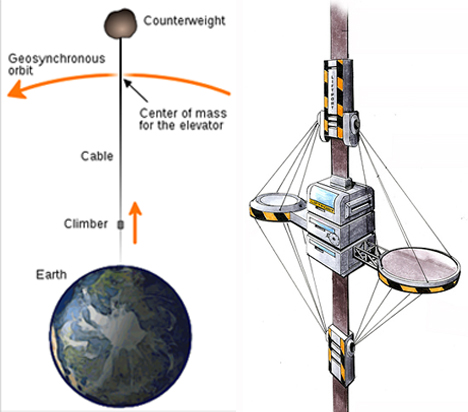This
week’s discussion of space exploration and art was a truly perfect way to sum
up this quarter’s discussion of the intersection of art and science and their continued
influence on one another. From this week’s topics, I was particularly struck by
the influence of science fiction writing on real scientific advances in human
space travel and exploration. It is incredible to think that one person’s
creative, innovative ideas portrayed in a popular novel greatly impact the
scientific community to such an enormous extent. The Space Elevator may be the
perfect example of the intersection of art and science, as an artist first came
up with this idea, and scientists are working to make it a reality.
 |
| Artist's rendering of Space Elevator http://science.nasa.gov/science-news/science-at-nasa/2000/ast07sep_1/ |
Arthur
Clarke, an engineer, humanist and futuristic science fiction writer, wrote the
novel “The Fountains of Paradise” in 1976. Set in the twenty second century, Clarke
most notably described a Space Elevator that would ultimately connect earth to
space. Ultimately, the elevator would consist of an orbital tower that rises
from the ground of earth and connects to a geostationary orbit 36,000
kilometers into space. The elevator could serve as a passage not only for
supplies into space, but as a means of travel for human beings as well.
 |
| http://iv1.lisimg.com/image/50745/600full- the-fountains-of-paradise-cover.jpg |
 |
| http://swh.schoolworkhelper.netdna-cdn.com/ wp-content/uploads/2011/06/Arthur-Clarke.jpg?c71720 |
While
the Space Elevator was first introduced as science fiction, it may not stay
that way for long, as scientists are truly considering using this idea of an
elevator into space as a type of mass transit system. After a conference with scientists
and engineers, David Smitherman of NASA compiled plans for the elevator,
confident that it may become reality.
 |
| This depiction of the elevator clearly describes the layout http://cdn.gajitz.com/wp-content/uploads/2009/09/illustration-and-climber.jpg |
The new
technology involved in the Space Elevator would make use of the nanotechnology,
nanotubes, that was discussed in lecture last week. A ribbon made out of carbon
nanotubes would stretch from earth to space, and a counterweight would spin
around the earth to keep the ribbon straight and allow robotic lifters to move
up and down the ribbon, to and from earth.
| Nanotube http://common.ziffdavisinternet.com/encyclopedia_images/_CNTUBE.GIF |
While we may
be years away from actually seeing the Space Elevator in progress, it is still
incredible to realize that the idea for this new and innovative technology came
from a science fiction novel. With the concept as an imaginative creation of an
artist, and the real application as the combination of scientists and engineers
using robotics and nanotechnology, the Space Elevator clearly demonstrates just
how extraordinary art and science can be when combined.
Works Cited
“About
Sir Arthur.” The Arthur C Clarke
Foundation. N.p., n.d. Web. 30 May 2015.
<http://www.clarkefoundation.org/sample-page/>.
“Audacious
& Outrageous: Space Elevators.” NASA
Science. NASA, n.d. Web. 30 May 2015.
<http://science.nasa.gov/science-news/science-at-nasa/2000/ast07sep_1/>.
Bonsor,
Kevin. “How Spae Elevators Will Work.” HowStuffWorks.
HowStuffWorks.com, n.d. Web. 30 May 2015.
<http://science.howstuffworks.com/space-elevator.htm>.
“Space
Elevator (Orbital Tower) by Arthur C. Clarke from the Fountains of Paradise.” Technovelgy. N.p., n.d. Web. 30 May
2015. <http://www.technovelgy.com/ct/content.asp?Bnum=720>.
“The
Fountains of Paradise.” Wikipedia.
Wikimedia Foundation, n.d. Web. 30 May 2015.
<http://en.wikipedia.org/wiki/The_Fountains_of_Paradise>.
Vesna,
Victoria. “Space Exploration and Art.” Cole UC online. Youtube, 29 May 2015.
Lecture.
I really enjoyed your post about the space elevator. I totally agree that many fictional ideas lead to real life inventions. I think that artists have a huge role in the advancement in technology because they think differently from scientists in some ways, and that can be used as an advantage. Good job connecting last weeks lecture with this weeks.
ReplyDelete